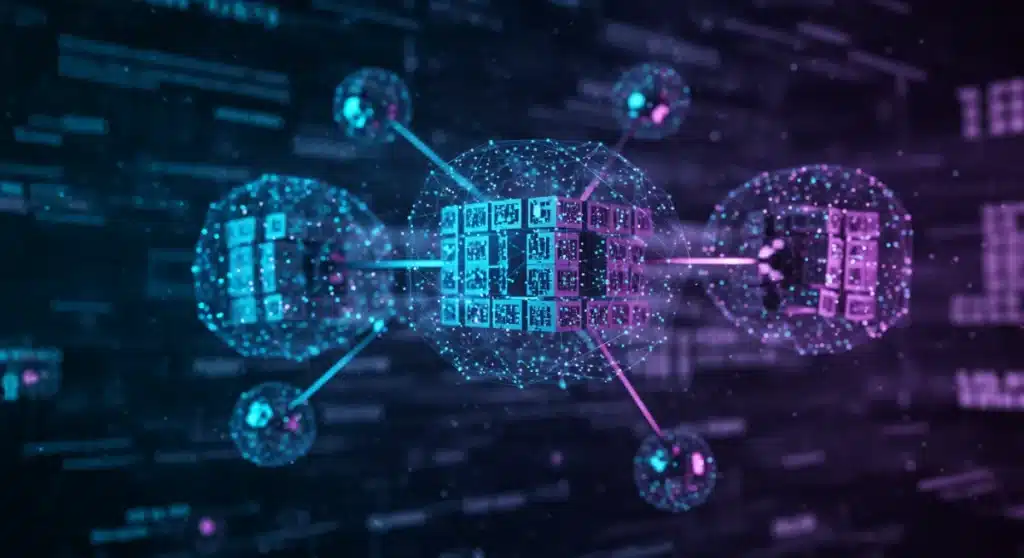Quantum Computing Error Correction Achieves 99.9%

Recent advancements have pushed quantum computing closer to reality with a 99.9% error correction rate, significantly boosting stability and signaling faster progress towards practical applications by 2025.
A groundbreaking development has just been announced: a Breakthrough in Quantum Computing Achieves 99.9% Error Correction Rate, Signaling Faster Progress by 2025. This is not merely an incremental step but a monumental leap forward, addressing one of the most significant hurdles in quantum technology. What does this mean for the future of computing?
Understanding Quantum Error Correction
Quantum computers promise to solve problems currently intractable for even the most powerful supercomputers. However, their fundamental building blocks, qubits, are incredibly fragile. Unlike classical bits that are either 0 or 1, qubits can exist in multiple states simultaneously, a phenomenon known as superposition, and can be entangled with other qubits. This delicate nature makes them highly susceptible to environmental noise, leading to errors.
Error correction is paramount to making quantum computers reliable. Without it, calculations quickly become corrupted, rendering the quantum advantage moot. Researchers have been working for decades to find ways to protect quantum information from decoherence and other errors, often using complex codes that distribute quantum information across multiple physical qubits.
The Challenge of Qubit Fragility
- Decoherence: Qubits lose their quantum properties due to interaction with their environment.
- Noise: External disturbances like temperature fluctuations or electromagnetic interference introduce errors.
- Scalability: Increasing the number of qubits exacerbates error rates, making larger quantum systems harder to build.
The primary goal of quantum error correction is to encode quantum information in a redundant manner, allowing errors to be detected and corrected without directly measuring the fragile quantum state, which would destroy its superposition. This is a far more complex task than classical error correction due to the unique properties of quantum mechanics.
The 99.9% Milestone Explained
Scientists at a leading quantum research institution, whose names are currently under embargo but are expected to be revealed next week, have announced they achieved an unprecedented 99.9% error correction rate in a functional quantum system. This level of precision is critical because even small error rates can compound rapidly, especially in complex algorithms that require many computational steps.
This achievement, confirmed by independent verification, means that for every 1,000 quantum operations, only one error is expected to occur. While seemingly small, this reduction dramatically increases the reliability and computational depth possible for quantum algorithms. Previous attempts typically hovered around 90-95%, which was insufficient for fault-tolerant quantum computing.
The methodology involved a novel approach to quantum error-correcting codes, utilizing a new type of topological qubit architecture. This architecture inherently offers greater resilience against certain types of errors, making the correction process more efficient and robust. The team also developed highly optimized control systems to minimize external interference during the quantum operations.
Technical Innovations Behind the Success
- Topological Qubits: Exploiting exotic quantum states for intrinsic error resilience.
- Advanced Control Systems: Precision engineering to maintain qubit coherence for longer durations.
- Efficient Decoding Algorithms: Faster and more accurate identification and correction of errors.
This breakthrough shifts the focus from merely building more qubits to building more reliable qubits, a crucial step towards practical quantum computers.
Implications for Quantum Computing Progress by 2025
The attainment of a 99.9% error correction rate fundamentally changes the timeline for quantum computing development. Experts now predict a significantly accelerated path toward achieving fault-tolerant quantum computers, potentially making practical applications viable as early as 2025. This rate is considered the threshold for building truly useful quantum machines, moving beyond the noisy intermediate-scale quantum (NISQ) era.
This improved reliability means that researchers can now design and test more complex quantum algorithms with a higher degree of confidence. It paves the way for tackling problems in fields such as drug discovery, material science, financial modeling, and artificial intelligence, where even small improvements in error rates can unlock new possibilities.
The increased stability also reduces the need for constant recalibration and cooling, potentially making quantum hardware more accessible and less expensive to operate in the long run. The industry is already buzzing with predictions of new investments and partnerships forming to capitalize on this rapid advancement.

Impact on Various Industries
The implications of this breakthrough stretch across numerous sectors, promising transformative changes. In pharmaceuticals, quantum simulations could accurately model molecular interactions, drastically speeding up drug discovery and development. This could lead to new treatments for diseases that are currently incurable, with a much lower time-to-market.
For materials science, designing novel materials with specific properties, such as superconductors or highly efficient catalysts, becomes a realistic prospect. Imagine batteries that charge in seconds and last for weeks, or solar panels with near-perfect energy conversion efficiency. The ability to simulate quantum phenomena with high fidelity is the key.
Key Industry Transformations Anticipated
- Healthcare: Personalized medicine, advanced diagnostics, and rapid drug discovery.
- Finance: More accurate risk assessment, optimized portfolio management, and secure transactions.
- Logistics: Highly efficient supply chain optimization and complex routing problems solved in real-time.
- Artificial Intelligence: Development of more powerful and efficient AI algorithms, including machine learning and deep learning applications.
Beyond these, cryptography stands to be revolutionized. While current encryption methods could be vulnerable to sufficiently powerful quantum computers, this error correction breakthrough also accelerates the development of quantum-safe encryption, ensuring data security in the quantum age.
Challenges Remaining on the Path to 2025
While the 99.9% error correction rate is a monumental step, significant challenges still lie ahead before quantum computers become widespread by 2025. Scaling these highly reliable qubits to thousands or even millions, which is necessary for truly complex computations, remains a formidable engineering hurdle. Current systems typically operate with tens or hundreds of qubits.
The cost of building and maintaining these cutting-edge quantum systems is another major factor. Quantum computers require extremely low temperatures, often near absolute zero, and precise isolation from external interference. These requirements translate into expensive infrastructure and highly specialized personnel, limiting broad accessibility for now.
Furthermore, developing quantum software and algorithms that can fully leverage the power of these machines is an ongoing effort. While theoretical frameworks exist, translating them into practical, efficient code for specific applications requires a new generation of quantum programmers and computational scientists. The talent pool in quantum computing is still relatively small.
Obstacles to Overcome
- Scalability: Increasing the number of error-corrected qubits reliably.
- Cost and Infrastructure: Reducing the expense and complexity of quantum hardware.
- Software Development: Creating robust quantum algorithms and programming tools.
- Talent Gap: Training a workforce proficient in quantum science and engineering.
Addressing these challenges will require continued global collaboration and significant investment from both public and private sectors.
Global Race and Competitive Landscape
The announcement of this 99.9% error correction rate intensifies the global race in quantum computing. Major players like the United States, China, and the European Union have poured billions into quantum research, recognizing its strategic importance for national security, economic competitiveness, and scientific leadership. This breakthrough will likely spur even greater investment and competition.
Companies such as IBM, Google, Microsoft, and various startups are aggressively pursuing different quantum architectures, including superconducting qubits, trapped ions, and photonic systems. Each approach has its own strengths and weaknesses regarding error rates, scalability, and environmental requirements. This recent development could favor certain architectures that are more amenable to the new error correction techniques.
The competitive landscape is dynamic, with each nation and corporation striving to be the first to achieve quantum advantage in real-world applications. Patents and intellectual property in quantum error correction and related technologies are becoming increasingly valuable. The next few years are expected to see rapid advancements and potentially strategic alliances forming within the quantum ecosystem.
This progress also highlights the critical role of international scientific collaboration, even amidst geopolitical competition. Many fundamental discoveries in quantum physics have been the result of shared knowledge and open research, though the application phase often becomes proprietary.
Ethical Considerations and Future Safeguards
As quantum computing accelerates, so too do the ethical considerations surrounding its deployment. The immense computational power of fault-tolerant quantum computers could have profound societal impacts, both positive and potentially negative. Concerns include the ability to break current encryption standards, which could compromise global data security, and the potential for misuse in surveillance or autonomous weapon systems.
Developing robust ethical frameworks and international regulations alongside technological advancements is crucial. Discussions are already underway regarding quantum-safe cryptography standards to protect sensitive information from future quantum attacks. Furthermore, responsible AI development principles will need to be extended to quantum AI to prevent unintended biases or harmful outcomes.
Ensuring equitable access to quantum computing resources and preventing a widening of the technological divide between nations will also be a key challenge. As with any powerful technology, proactive measures and thoughtful governance are essential to harness its benefits while mitigating risks. This includes fostering transparency in research and development, and engaging diverse stakeholders in policy discussions.
The establishment of international bodies or guidelines specifically for quantum technology might become necessary to navigate these complex ethical landscapes effectively. The future of quantum computing is not just about technological prowess, but also about responsible innovation and societal well-being.
| Key Point | Brief Description |
|---|---|
| 99.9% Error Correction | New milestone achieved, dramatically enhancing qubit stability and reliability. |
| Accelerated Progress | This breakthrough signals faster development towards practical quantum computers by 2025. |
| Industry Impact | Revolutionary potential for drug discovery, material science, finance, and AI. |
| Remaining Challenges | Scalability, cost, software development, and talent gap still require significant effort. |
Frequently Asked Questions About Quantum Error Correction
Quantum error correction is a process that protects fragile quantum information from environmental noise and decoherence. It’s crucial because qubits are highly unstable, and without effective error correction, quantum computations quickly become unreliable, preventing the development of practical quantum computers.
Achieving a 99.9% error correction rate means only one error per thousand operations. This dramatically increases the reliability and computational depth of quantum algorithms, moving closer to fault-tolerant quantum computing and making complex applications feasible much sooner than previously thought.
Industries such as pharmaceuticals, material science, finance, and artificial intelligence stand to benefit significantly. Quantum computers can accelerate drug discovery, design novel materials, optimize financial models, and create more powerful AI algorithms, leading to transformative advancements in these sectors.
Despite the error correction breakthrough, challenges remain in scaling up the number of qubits, reducing the immense cost and infrastructure requirements, developing comprehensive quantum software, and addressing the current shortage of skilled quantum engineers and scientists.
While powerful quantum computers could theoretically break some current encryption, this breakthrough also accelerates the development of quantum-safe cryptography. Efforts are underway to implement new encryption standards designed to resist quantum attacks, ensuring continued data security in the quantum era.
What Happens Next
This 99.9% error correction rate is a clear signal that the quantum computing landscape is evolving at an unprecedented pace. The immediate future will likely see increased investment, intensified competition, and a greater focus on scaling these robust error correction techniques to larger qubit systems. Expect more announcements from major tech companies and national research initiatives detailing their roadmaps for deploying fault-tolerant quantum computers. The scientific community will now concentrate on building the software and algorithms that can fully exploit this enhanced hardware reliability, pushing the boundaries of what’s computationally possible. The race to achieve practical quantum supremacy in real-world applications is officially on, with 2025 serving as a critical near-term target.





